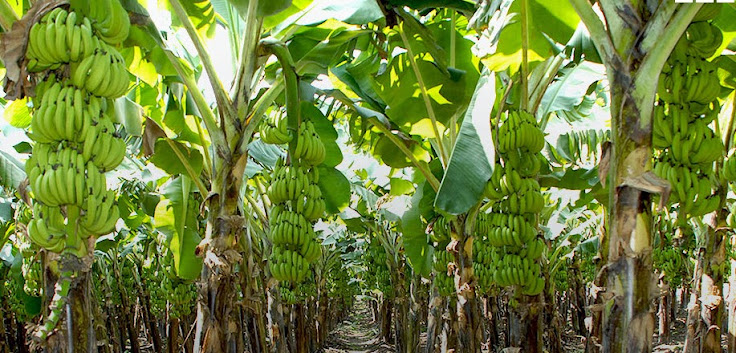Insect Pests – Pseudostem Weevil / Borer:
Symptoms:
The Pseudostem
weevil (Odoiporus longicollis) are normally black coloured ones but red coloured
variants are also found in some areas. The pest breeds and become more active during
summer and monsoon seasons.
Early symptoms of
infestation are the presence of small pin-head sized holes on the pseudostem,
fibrous extrusions from bases of the leaf petioles and exudation of a gummy
substance from the holes of the pseudostem.
The weevil larvae
are fleshy and yellowish white. Larva bores hole through the pseudostem and
thrives inside. This results in exudation of plant sap followed by dropping of
the faecal matter. As the central core is destroyed due to the boring of the
larvae, upward movement of the nutrient is hampered which ultimately results in
poor growth and development of the plants.
If the larva
tunnels pseudostem during advanced pre-flowering stage, the ascending flower
bud and peduncles are destroyed resulting in non emergence of the flower bud
which decays inside the pseudostem. This leads to choked throat appearance of
bunch and breaking of Pseudostem.
During advanced
stages of infestation, we can observe by splitting the stem, the pests' extensive tunneling both in the
leaf sheath and in the rhizome. Rotting occurs due to secondary infection of
other pathogens and foul odour is emitted. When the rhizome and peduncle are
tunnelled after flowering, the fruits do not develop properly, exhibiting a
dehydrated condition with premature ripening of the bunch.
 |
| Pseudostem weevil affected plant with immature bunch |
 |
| Pseudostem weevils / grubs |
 |
| Pseudostem weevil attack - Bore hole on Banana |
Control:
- Keep the plantation clean.
- Remove trashes and burn the refuse.
- Do not dump infected plant into manure pit.
- Uproot infected trees, chop into pieces and burn.
- You can be rest assured of infection free planting
material if you go for ‘Tissue culture plants. If you opt for suckers, then avoid planting of borer
infested suckers. To make sure that you have clean suckers, the roots
should be trimmed and pared-off all tissues on the surface to make it free
of any infestations and dip the pared corm in a solution containing 0.5%
Monocrotophos or 2.5 ml in 1 litre solution of Trizophos for 30 minutes. Alternatively application of 40g of
Carbofuran in the soil at planting can also be followed.
- Do not plant susceptible varieties in the endemic areas
such as Nendran, Mondan, Ney poovan etc.
- Dilute Monocrotophos 150 ml in 350 ml of water and inject 4 ml in the
pseudostem about 2 feet higher from the ground (preferably below bore
hole) using Pseudostem injector in a 45 degree slanting angle. For more
details click this link: A novel method for effective control of Pseudostem weevil using Pseudostem Injector.
- Rake the soil around the pseudostem and apply 0.1%
Metasystox or 0.05% Quinalphos or 0.03% Chlorpyriphos or 0.2% Carbaryl
followed by light irrigation, at 15 days interval.
- Method to trap the weevil with spilt pseudostem: The
freshly cut pseudostem is a good breeding place for weevils. So, after the
bunch has been harvested, cut the pseudostem close to the ground then cut it
into small pieces in lengths of up to 60 cm, split each along its length
and place them in the soil in the way that the cut portion faces the
ground. These cut pieces (split traps) attract adult female weevils to feed and lay
their eggs. As soon as the larvae emerge, these pieces become dry and
eventually the larvae die because of dehydration. This split trap method to trap the weevil is just to monitor the extent of infection in the field and control measures have to be taken up immediately.
- The open cut side of the above pseudostem cut pieces about 30 to 40 numbers (split traps) can be sprayed with 0.5% solution of Beauveria bassiana or Metarhizium anisopliae, both are entomopathogenic bio control agents before placing them face down on the soil. The weevil gets infected by the fungal conidia (spores) when it enters the pseudostem trap. It is enough for the conidia of the fungus to come in to contact with the body of the weevil or ingested where it grow and colonize the host body. Then they germinate and the hyphae that emerge penetrate the cuticle of the insect host. After extensive invasion of the host body, the Destruxins produced by the fungus eventually weaken and kill the insects within 72 hours.
- Use Pheromone traps (2 traps/acre) and destroy the collected weevils.
 |
| A Pseudostem Injector and a Pseudostem cut piece for weevil trap |
Regards,
A.Vishnu Sankar










.jpg)











 15:51
15:51
 Tissue Culture Banana Cultivation Technology
Tissue Culture Banana Cultivation Technology

 Posted in:
Posted in: 












